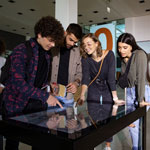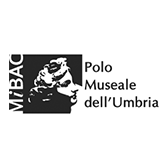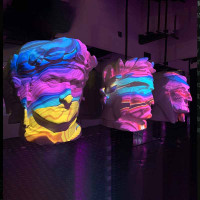
CULTURAL HERITAGE
Culture heritage becomes an experience
Solutions to attract visitors, entertain them and inform them through digital engagement.

The Studiolo of Federico da Montefeltro, a veritable treasure trove of culture, art and beauty, can no longer be found at the Ducal Palace of Gubbio. It was commissioned by the Duke in the late 1470s, and consisted of a series of richly inlaid panels, which covered nearly two-thirds of the walls’ height. There were also several paintings, of which only a few traces remain. The inlaid walls were dismantled and sold to Prince Lancellotti in 1874, and were later purchased by the Metropolitan Museum of New York in 1939. As a result, the Studiolo and its priceless trove of Renaissance culture is now fragmented and divided.
In order to remedy this problem, meticulously crafted replicas of the wooden walls, made by local cabinet-makers and restorers, were installed in 2009, as a first step towards the restoration of this important piece of history.
In order to allow visitors to once again admire the Studiolo, a major project was announced in 2017, financed by the Cassa di Risparmio di Perugia Foundation, in collaboration with scholars from the University of Bologna, the Polytechnic University of Turin, the University of Perugia, and the Museum Center of Gubbio. The Touchwindow team was approached in order to help arouse young people’s interest in this cultural heritage through digital interaction, by providing them with a great deal of content linked to the Studiolo itself: an place that embodies the passion for culture and beauty typical of the Renaissance.
The project was aimed at creating an environment that, starting with the digital replica of Montefeltro’s Studiolo, would provide for an interactive experience of discovery. Essentially engaging visitors in a journey through time and space, where the potential offered by the digital world can be exploited in order to bring together a wide range of multimedia materials, for a unique and exhilarating experience.
The project involved the digital reconstruction of the Studiolo, in order to transform it into an interactive map for launching thematic pathways made up of literary, audible, and iconographical contents. We therefore began by photographing the inlays currently on display at the Metropolitan Museum of New York, one of the project’s partners, in order to create an accurate virtual replica of the Studiolo. Starting with this, we identified the hot-spots that would provide access to the historical and scientific contents, in order to give depth and insight to the virtual tour. The Studiolo thus becomes a gateway to the Renaissance, allowing visitors to extend their knowledge in a more engaging way.
The digital replica is completed with a video-narration, which will also serve as a guide for future multimedia installations. The tour even features a sound dome in order to allow the sound content to be enjoyed through an entirely immersive experience.
During the course of the project’s operational development, we were engaged in acquiring all the contents and incorporating them within the interactive project, with particular attention being paid to the Renaissance musical passages, which were faithfully reproduced by the Ensemble Micrologus.
The virtual tour of Federico da Montefeltro’s Studiolo was presented to the public on February 1st, 2019, and was immediately received with keen interest. The overall project, elaborated by a pool of skilled experts and scholars, was selected as a finalist for the ninth edition of the prestigious Premio nazionale Cultura di Gestione award, presented by Federculture, Agis, Alleanza Cooperative Italiane Turismo e Beni Culturali and Forum del Terzo Settore.
To quote the Director of the Ducal Palace of Gubbio, Paola Mercurelli Salari, "its strength lies in the working method, which led to the development of a new interactive tool that's designed specifically for young people and uses a language they're familiar with."

Solutions to attract visitors, entertain them and inform them through digital engagement.

Offer advanced digital environments with which to bring citizens closer, open new spaces to interact with them, and provide innovative services.

Discover our interactive and immersive solutions for the “Piano Scuola 4.0”, an important opportunity to make schools a participatory environment with engaging teaching methods and more learning opportunities for students.

Ravenna’s Dante Museum becomes a place of time into time, where the modern interactive and multimedia aspects combine with prestigious historical artefacts of inestimable value.

LIFE, the new multimedia space at the Tourin University